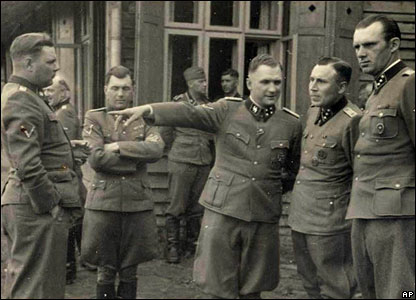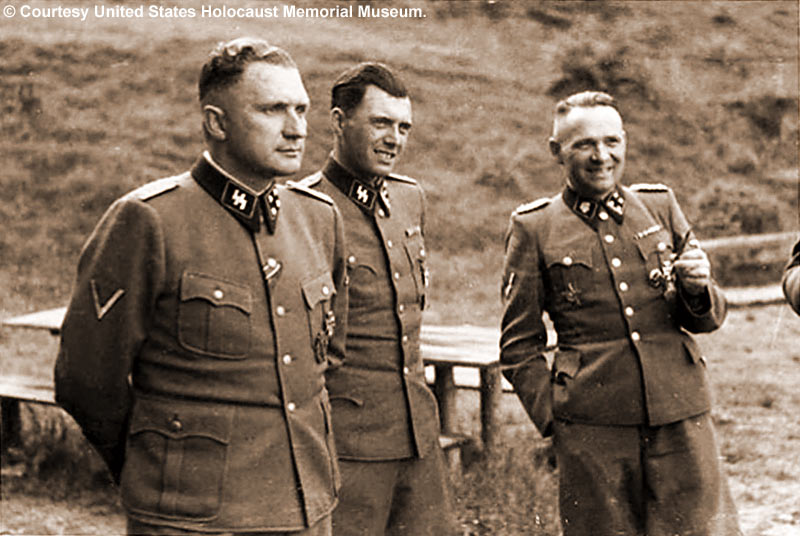<Back to Index>
- Astronomer Caroline Lucretia Herschel, 1750
- Poet Rene François Armand (Sully) Prudhomme, 1839
- Captain of the SS Josef Rudolf "Todesengel" Mengele, 1911
PAGE SPONSOR
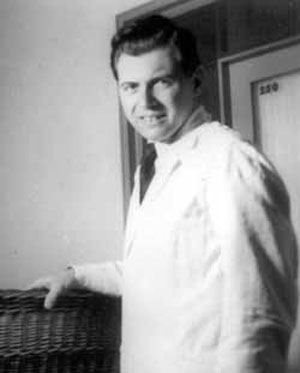
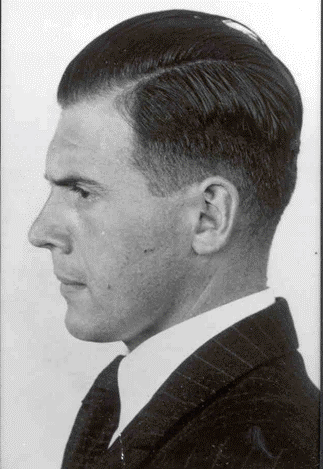
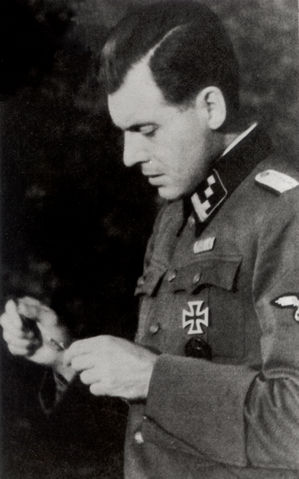
Josef Rudolf Mengele (16 March 1911 – 7 February 1979), also known as the Angel of Death (Todesengel in German) was a German SS officer and a physician in the Nazi concentration camp Auschwitz - Birkenau. He earned doctorates in anthropology from Munich University and in medicine from Frankfurt University. He initially gained notoriety for being one of the SS physicians who supervised the selection of arriving transports of prisoners, determining who was to be killed and who was to become a forced labourer, but is far more infamous for performing grisly human experiments on camp inmates, for which Mengele was called the "Angel of Death".
In 1940, he was placed in the reserve medical corps, following which he served with the 5th SS Panzergrenadier Division Wiking in the Eastern Front. In 1942, he was wounded at the Russian front and was pronounced medically unfit for combat, and was then promoted to the rank of SS-Hauptsturmführer (Captain) for saving the lives of three German soldiers. He survived the war, and after a period living incognito in Germany he fled to South America, where he evaded capture for the rest of his life despite being hunted as a Nazi war criminal.
Josef Mengele was born, the eldest of 3 children, to Karl and Walburga Mengele in Günzburg, Bavaria, Germany. Mengele's father was a founder of the Karl Mengele & Sons company, a company that produced farm machinery for milling, sawing, and baling. In 1935, Mengele earned a Ph.D in Anthropology from the University of Munich. In January 1937, at the Institute for Hereditary Biology and Racial Hygiene in Frankfurt, he became the assistant to Dr. Otmar Freiherr von Verschuer who was a leading scientist mostly known for his research in genetics with a particular interest with twins. From this association, Mengele probably developed his life long fascination with the study of twins. In addition Mengele studied under Theodor Mollison and Eugen Fischer, who had been involved in medical experiments on the Herero tribe in (what is now) Namibia.
In 1937 Mengele joined the Nazi Party. In 1938 he received his medical degree and joined the SS. Mengele was conscripted into the army in 1940 and later volunteered to the medical service of the Waffen-SS, the combat arm of the SS, where he distinguished himself as a soldier. In June 1941 he was awarded the Iron Cross Second
Class for his efforts at the Ukrainian Front. In January 1942, while
serving with the SS Wiking Division deep behind Soviet lines, he pulled
two German soldiers from a burning tank, and was awarded the Iron Cross
First Class as well as the Black Badge for the Wounded and the Medal
for the Care of the German People. Mengele was wounded during this
campaign; since he could not return to combat, he was posted at the Race and Resettlement Office in Berlin.
He resumed an association with his mentor, von Verschuer, who was at
the Kaiser Wilhelm Institute for Anthropology, Human Genetics and
Eugenics in Berlin. Just before he was transferred to Auschwitz, Mengele was promoted to the rank of SS captain in April 1943. In May 1943, Mengele replaced another doctor who had fallen ill at the Nazi extermination camp Birkenau. On May 24, 1943, he became medical officer of Auschwitz - Birkenau's "Gypsy camp". In August 1944, this camp was liquidated and all its inmates gassed. Subsequently Mengele became Chief Medical Officer of the main infirmary camp
at Birkenau. He was not, though, the Chief Medical Officer of Auschwitz
— superior to him was SS-Standortarzt (garrison physician) Eduard Wirths. During his 21-month stay at Auschwitz, Mengele earned the sobriquet "Angel of Death" for the cruelty he visited upon prisoners. Mengele was referred to as "der weiße Engel"
("the White Angel") by camp inmates because when he stood on the
platform inspecting new arrivals and directing some to the right, some
to the left (the gas chambers),
his white coat and white arms outstretched evoked the image of a white
angel. Mengele took turns with the other SS physicians at Auschwitz in
meeting incoming prisoners at the camp, where it was determined who
would be retained for work and who would be sent to the gas chambers immediately. In one instance, he drew a line on the wall of the children's block 150 centimetres (about 5 feet) from the floor, and sent those whose heads could not reach the line to the gas chamber. "He had a look that said 'I am the power,'" said one survivor. When it was reported that one block was infested with lice, Mengele ordered the 750 women assigned to it to be gassed. Mengele used Auschwitz as an opportunity to continue his research on heredity, using inmates for human experimentation. He was particularly interested in identical twins; they would be selected and placed in special barracks. He also recruited Berthold Epstein, a Jewish pediatrician. As a doctor, Epstein proposed to Mengele a study into treatments of the disease called Noma that was noted for particularly affecting children from the camp. While the exact cause of Noma remains uncertain, it is now known that it has a higher occurrence in children suffering from malnutrition and a lower immune system response. Many develop the disease shortly after contracting another illness such as measles or tuberculosis. Mengele took an interest in physical abnormalities discovered among the arrivals at the concentration camp. These included dwarfs, notably the Ovitz family - the children of a Romanian artist, of whom seven of the ten members were dwarfs. Prior to their deportation, they toured in Eastern Europe as the Lilliput Troupe. Mengele often called them "my dwarf family"; to him they seemed to be the perfect expression of "the abnorm". Mengele's
experiments also included attempts to take one twin's eyeballs and
attach them to the back of the other twin's head, changing eye colour
by injecting chemicals into children's eyes, various amputations of limbs, and other surgeries. Rena Gelissen's account of her time in Auschwitz details certain experiments performed
on female prisoners around October 1943. Mengele would experiment on
the chosen girls, performing sterilization and shock treatments. Most of the victims died, because of either the experiments or later infections. At
Auschwitz, Mengele did a number of twin studies. After the experiment
was over, these twins were usually killed and their bodies dissected.
He supervised an operation by which two Romani children were sewn
together to create conjoined twins; the hands of the children became badly infected where the veins had been resected, this also caused gangrene. The
subjects of Mengele's research were better fed and housed than ordinary
prisoners and were, for the time being, safe from the gas chambers. When
visiting his child subjects, he introduced himself as "Uncle Mengele"
and offered them sweets. Some survivors remember that despite his grim
acts, he was also called "Mengele the protector". The book Children of the Flames,
by Lucette Matalon Lagnado and Shiela Cohn Dekel, chronicles Mengele's
medical experimental activities on approximately 3,000 twins who passed
through the Auschwitz death camp during World War II until its
liberation at the end of the war. Only 100 pairs of twins survived; 60
years later, they came forward about the special privileges they were
given in Auschwitz owing to Mengele's interest in twins, and how as a
result they have suffered, as the children who survived his medical
experiments and injections. Auschwitz
prisoner Alex Dekel has said: "I have never accepted the fact that
Mengele himself believed he was doing serious work — not from the
slipshod way he went about it. He was only exercising his power.
Mengele ran a butcher shop — major surgeries were performed without anaesthesia.
Once, I witnessed a stomach operation — Mengele was removing pieces
from the stomach, but without any anaesthetic. Another time, it was a
heart that was removed, again without anaesthesia.
It was horrifying. Mengele was a doctor who became mad because of the
power he was given. Nobody ever questioned him — why did this one die?
Why did that one perish? The patients did not count. He professed to do
what he did in the name of science, but it was a madness on his part."
In Buenos Aires,
Mengele at first worked in construction, but soon came in contact with
influential Germans, who allowed him an affluent lifestyle in
subsequent years. He also got to know other Nazis in Buenos Aires, such
as Hans-Ulrich Rudel and Adolf Eichmann. In 1955, he bought a 50 percent share of Fadro Farm, a pharmaceutical company;
the same year, he divorced his wife, Irene. Three years later, he
married Martha Mengele in Uruguay, the widow of his younger brother,
Karl Jr.; she then went to Argentina with her 14-year-old son, Dieter.
Mengele lived with his family in a German owned boarding house in the
Buenos Aires suburb of Vicente Lopez from 1958 to 1960. While in Buenos Aires, Mengele practiced medicine, specializing in illegal abortions and was briefly detained by police on one occasion for the death of a patient during an abortion. He
was doing well in South America, yet Mengele feared being captured,
especially after news of Eichmann's capture and subsequent trial were
revealed. Thus, he left Argentina in 1962 and moved to Paraguay after
managing to get a Paraguayan passport in the name of "José
Mengele". Shortly after the capture of Eichmann in May 1960 by the Israeli Mossad,
Mengele was spotted at his home. Agents of Mossad debated whether or
not to also kidnap him. However, they still had Eichmann in a safe
house inside Argentina, and determined that it would not be possible to
conduct another operation at the same time. By the time Eichmann had
been brought out of the country, Mengele had escaped to Paraguay. Mengele was a secondary objective of this operation, but was never found. Isser Harel, Chief Executive of the Secret Services of Israel (1952 – 1963), personally presided over the successful effort to capture Eichmann in Buenos Aires.
In his account of the operation, he reports no sightings of Mengele in
1960, but feels that they might have got him if they could have moved
more quickly. When asked about the secondary target by the co-pilot who
helped transport Eichmann at the time, he claims to have told him that
"had it been possible to start the operation several weeks earlier,
Mengele might also have been on the plane." They checked on the last
known location for Mengele in Argentina, but he had apparently moved on just two weeks prior. Mengele hoped that Paraguay would be safer for him, as dictator Alfredo Stroessner was
of German descent and even recruited former Nazis to help the country
develop. Among other locations in Paraguay, he lived on the outskirts of Hohenau, a German colony north of Encarnación in the department of Itapúa.
His anxiety, however, haunted him, especially after he heard of the
Mossad's abduction of Eichmann and the trial and execution in Israel. According
to a senior Mossad man, Israel had received reports that Mengele was in
Brazil, but they kept this information to themselves. The Six-Day War in 1967 forced concentration of resources. But after the war, Israel decided to open an embassy in Asunción, Paraguay — perhaps an ideal base from which to pursue Mengele. But
Benjamin Weiser Varon, Israeli ambassador from 1968 – 1972, was "not
given any instructions by the foreign office on Mengele of any kind. It
wasn't even mentioned." The same year, Mengele moved to Nova Europa, about 200 km (120 mi) outside São Paulo, where he lived with Hungarian refugees Geza and Gitta Stammer, working as manager of their farm. In the
seclusion of his Brazilian hideaway Mengele was safe. In 1974, when his
relationship with the Stammer family was coming to an end, Rudel and
Gerhard discussed relocating Mengele to Bolivia where he could spend time with Klaus Barbie,
but Mengele rejected this proposal. Instead, he lived in a bungalow in
a suburb of São Paulo for the last years of his life. In 1977,
his only son Rolf, never having known his father before, visited him
there and found an unrepentant Nazi who claimed that he "had never
personally harmed anyone in his whole life". Mengele's health had been deteriorating for years, and he died on February 7, 1979, in Bertioga, Brazil, where he accidentally drowned or possibly suffered a stroke while swimming in the sea. He was buried in Embu das Artes under the name "Wolfgang Gerhard", whose ID card he had used since 1976. Mengele
showed little regret or remorse for his crimes, and expressed in a
letter his astonishment and disgust over the remorseful position taken
by Hitler's chief architect and Minister of Armaments, Albert Speer. Argentine historian Jorge Camarasa speculated
in his 2008 biography that Mengele, under the alias Rudolph Weiss,
continued his human experimentation in South America and as a result of
these experiments, a municipality in Brazil, Cândido Godói,
has a very high birthrate of twin children: one in five pregnancies,
with a substantial amount of the population looking Nordic. His
theory was rejected by Brazilian scientists who had studied twins
living in the area; they suggested genetic factors within that
community as a more likely explanation. Mengele was listed on the Allies' list of war criminals as early as 1944. His name was mentioned in the Nuremberg trials several
times, but Allied forces were convinced that Mengele was dead, which
was also claimed by Irene and the family in Günzburg. In 1959,
suspicions had grown that he was still alive, given his divorce from
Irene in 1955 and his marriage to Martha in 1958. An arrest warrant was issued by the German authorities. Subsequently, German attorneys such as Fritz Bauer, Israel's Mossad, and private investigators such as Simon Wiesenthal and Beate Klarsfeld followed the trail of the "Angel of Death". The last confirmed sightings of Mengele placed him in Paraguay, and it was believed that he was still hiding there, allegedly protected by flying ace Hans-Ulrich Rudel and possibly even by President Alfredo Stroessner. Mengele sightings were reported all over the world, but they turned out to be false. In 1985, the German police raided Hans Sedlmeier's house in Günzburg and
seized address books, letters, and papers hinting at the grave in Embu.
Mengele was exhumed on 6 June 1985 and identified with high probability
by forensic experts from UNICAMP. Rolf Mengele issued a statement saying that he "had no doubt it was the remains of his father". Everything was kept quiet "to protect those who knew him in South America", Rolf said. In 1992, a DNA test confirmed Mengele's identity. He had evaded capture for 34 years. After
the exhumation, the São Paulo Institute for Forensic Medicine
stored his remains and attempted to repatriate them to the remaining
Mengele family members. The bones have remained in the custody of Dr.
Rubens Maluf, owing to the family's refusal to accept them. On September 17, 2007, the U.S. Holocaust Museum released photographs taken from a photo album of
Auschwitz staff, which contained eight photographs of Mengele. These
eight photos of Mengele are the first authenticated pictures of him at
Auschwitz, USHM museum officials said. In
February 2010, Mengele's diary, kept from 1960 till his death in 1979,
which included letters sent to Rolf and Wolfgang Gerhard was sold at an
auction in Connecticut by Alexander Autographs for an estimated
$100,000 (£40,000). According to the Jewish Telegraphic Agency
(JTA) the buyer was an East Coast Jewish philanthropist who wished to
be anonymous. The auction caused protest amongst some Holocaust
survivors, describing it as "a cynical act of exploitation aimed at profiting from the writings of one of the most heinous Nazi criminals." The previous owner, who acquired the diary in Brazil, is said to be close to the Mengele Family.
The SS abandoned the Auschwitz camp on January 27, 1945, and Mengele transferred to Gross Rosen camp in Lower Silesia, again working as camp physician. Gross Rosen was dissolved at the end of February when the Red Army was close to taking it. Mengele worked in other camps for a short time and, on May 2, joined a Wehrmacht medical unit led by Hans Otto Kahler, his former colleague at the Institute of Hereditary Biology and Racial Hygiene in Bohemia. The unit hurried west to avoid being captured by the Soviets and were taken as prisoners of war by
the Americans. Mengele, initially registered under his own name, was
released in June 1945 with papers giving his name as "Fritz Hollmann".
From July 1945 until May 1949, he worked as a farmhand in a small
village near Rosenheim, Bavaria, staying in contact with his wife and his old friend Hans Sedlmeier, who arranged Mengele's escape to Argentina via Innsbruck, Sterzing, Meran, and Genoa. Mengele may have been assisted by the ODESSA network.
